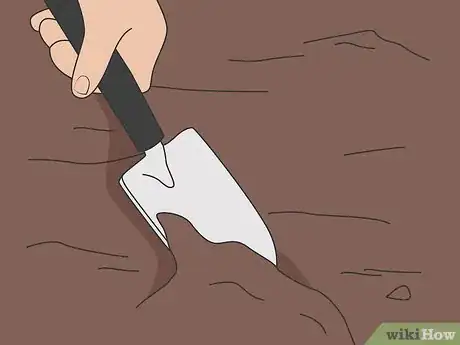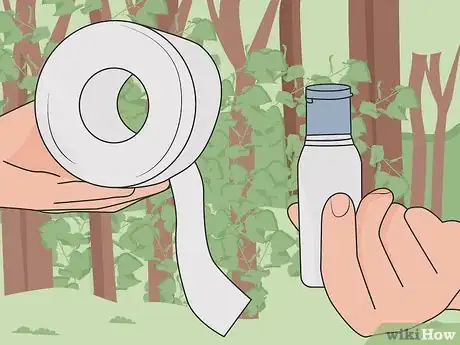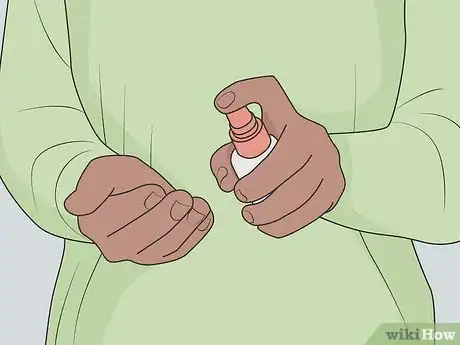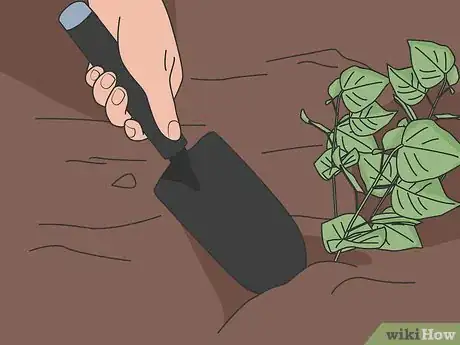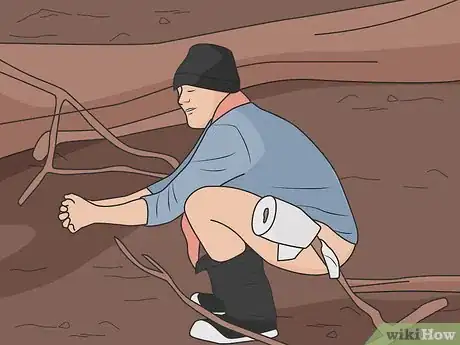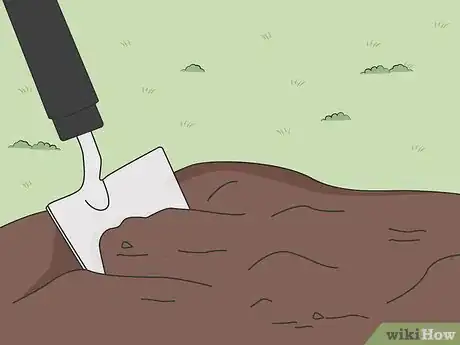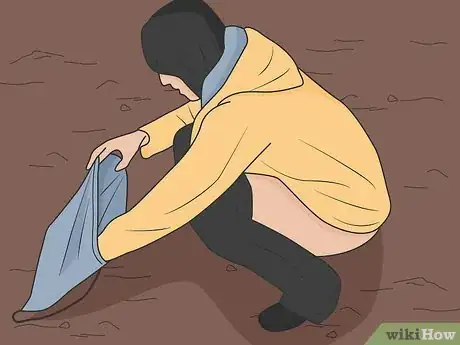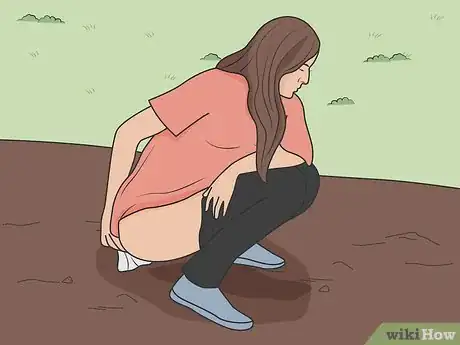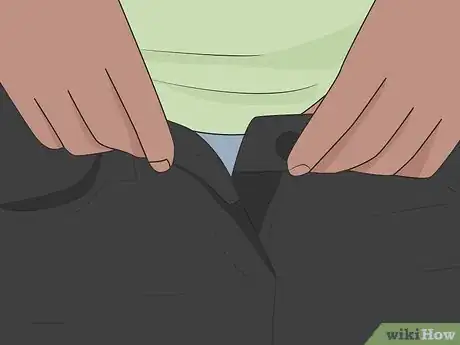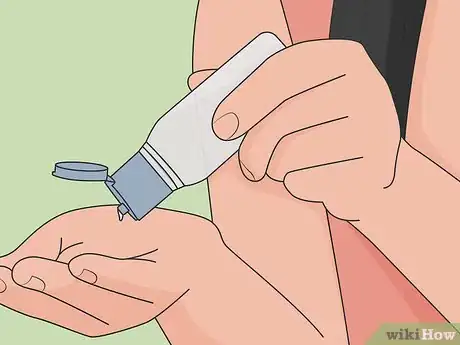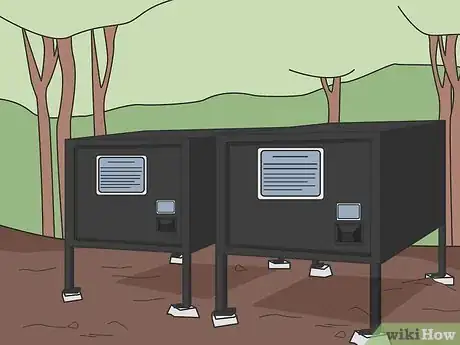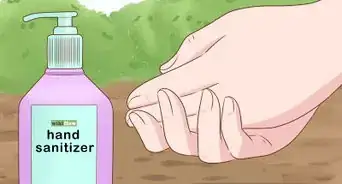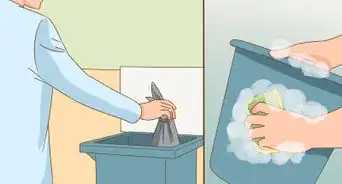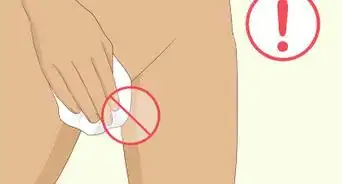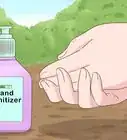This article was co-authored by Hannah Young. Hannah Young is an Outdoor Education Expert with more than three years of experience. She specializes in educating others on backpacking and hiking, land ethics and best practices, and wilderness Restoration. Hannah earned a BS in Earth Systems from Stanford University.
This article has been viewed 88,792 times.
If you ever need to relieve yourself outside without the conveniences of indoor plumbing, you might be in for a surprise. It can be quite difficult to find a good spot and urinate or defecate without making a mess or being seen, and without leaving behind evidence of your deed. By planning ahead, you can be prepared for adventures that might involve relieving yourself in the great outdoors.
Steps
Planning Ahead
-
1Know the law. In many countries and in every state in America, urinating and defecating in public is against the law. You can be charged with disorderly conduct if you are seen peeing or defecating in public places including public parks or public waterways.[1]
- In some very rare cases, urinating or defecating in public places can result in charges like indecent exposure or public lewdness, which can result in registering as a sex offender for the rest of your life.[2]
- Of course, there are circumstances when hiking or camping where you must relieve yourself even on public land. It is vitally important that you use common sense and ensure that you are in a relatively secluded area when you relieve yourself outdoors.
-
2Leave no trace. The ethical and responsible way to enjoy the great outdoors is by leaving no trace of your presence there after you've left. Not only does this mean leaving wildlife alone and not destroying natural landmarks, it also means leaving no trace that you've relieved yourself. This means you will need to properly bury your own fecal waste.[3]Advertisement
-
3Come prepared. If you will be spending time outdoors camping, hiking, or picnicking, plan on the fact that you and your friends will need to relieve yourselves at some point in the outing.
- You will need a small trowel or hand shovel for digging a hole to bury feces, a roll of toilet paper, and a plastic bag to cart out used toilet paper when you leave.
- You will also need waterless hand sanitizer or biodegradable soap and water. Soap and water are always preferable.
Defecating Outdoors
-
1Know the local regulations. Some places have a pack-it-out policy where everything (including solid human waste) must be disposed of outside of the park. Some places require that you pack out your toilet paper. Others let you bury both waste and toilet paper in your cathole.
Even if burying toilet paper is allowed, it is still more friendly to the environment and more in keeping with Leave-No-Trace principles to pack it out with you. Decide for yourself what you will do in advance, so you can be prepared with bags and supplies.
-
2Remember hygiene practices in advance. Because hand sanitizer and soap are going to have to get stored with the rest of your gear, you don't want to have to touch them with a dirty hand - for your sake but also the health of anyone else sharing them. You can either use exclusively one hand to do your bathroom business and then use the other to handle the hand sanitizer (in which case you may want to open the bottle in advance) or ask a friend for help - find the soap and say something like "Hey! I'm going to go use the bathroom. Can you help me pour some water on my hands when I get back?" Remember that soap and water are better than hand sanitizer, and good scrubbing is required either way. And you definitely want to know where they're located before your hands are contaminated.
-
3Choose your location. Because you have to be discreet and also have a place to bury your feces that is sanitary, you need to keep the following guidelines in mind before you squat:
- Choose a place that is well hidden from passersby, preferably with the cover of trees.
- Choose a place that is at least 200 feet away from water sources like lakes or streams, and away from campsites or other places where other people are likely to discover it.[4]
- Try to find a place with soft soil for digging.
-
4Dig a cathole. A cathole is a small hole for defecating, similar to how cats dig a hole prior to defecating in the wild. Using the trowel or hand shovel that you brought with you, dig a hole six inches deep and about four to six inches wide. It needs to be big enough to be a target as you squat above it, and also deep enough that animals will stay out. For many trowels, a good rule of thumb is "As deep as the blade of the trowel and with an equal diameter."[5]
-
5Squat and defecate. First, lower your underwear and pants. You can remove them entirely if you prefer, and drape them on a nearby tree or bush. Then, squat over your cathole and defecate directly into it. If you miss, use a stick to move your feces into the bottom of the hole.
-
6Wipe with toilet paper that you brought with you. While you might have seen people in movies using leaves for wiping, unless you have a thorough knowledge of local vegetation, don't try this yourself. You might end up with a blistering rash in the worst possible place. Then, dispose of the toilet paper in your preferred manner, in accordance with local regulations:
- Put your used toilet paper in the plastic bag you've brought with you, then seal it and put it in another plastic bag to conceal the smell. Take it all out with you and dispose of it when you find a trash can, or when you get home.[6]
- Avoid burying your toilet paper to leave as little impact on the environment as possible.
-
7Bury your waste. You must bury it for sanitary reasons. By burying your feces, you can reduce the risk of someone stepping in it or of spreading illness and germs.[7] Cover your feces with the soil that you dug out of your cathole, then cover it with sticks, leaves, or rocks to disguise it. This also helps keep animals away. You should ideally move the dirt back with your hand to avoid contaminating your trowel, but if you choose to use the trowel, remember that it is not allowed to touch the contents of your cathole. the trowel must remain clean for future use.
Warning: If you are camping with a group in an area where acceptable bathroom spots are few, the probability that someone else tries to dig a hole in the same place you dug a hole increases. In that case, you may want to mark your spot - for example by putting a vertical stick into the ground - until you vacate the area.
Urinating Outdoors For Females
-
1Find a private spot. Look for a place behind rocks or trees for privacy.
- Don't forget to bring your supplies, including toilet paper, plastic bags, and hand sanitizer.
-
2Lower your pants and underwear. If you're wearing a skirt, raise it and wrap it securely under one arm, then lower your underwear. If you have enough time and privacy, it's better to remove pants and underwear completely, just in case of urine dribbles.
- Set your pants and underwear on a dry spot on the ground or a nearby bush. Don't put them too close to you or you may soil them.
-
3Squat with your heels flat on the ground. You might be used to squatting on the balls of your feet, with your feet close together, but this position is very unstable and hard on the knees. Squatting with feet hip-width or shoulder-width apart and with your feet flat is easier to hold for an extended period of time.
- If you're wearing pants, be careful not to let things fall out of your pocket as you squat.
-
4Urinate. Push your urine stream hard at the beginning and at the end to get a strong stream and not dribble. Some women find it helpful to use one hand to spread the labia and better expose the urethral opening, but this can also be accomplished by spreading the legs a bit farther.
- If you prefer not to squat, you can try the steps in How to Urinate Standing up As a Female.
-
5Wipe with a pee rag, toilet paper, tissues or a wet wipe. Put disposable products in the plastic bag you brought for this purpose, and dispose of it when you get home or back to camp. A "pee rag" is a bandana or similar piece of cloth dedicated to this purpose that can be tied to the outside of your backpack (or otherwise left outside) after use, where it will dry.
Wiping is not generally necessary, and you can simply shake your bum a little bit while you're still squatting to shake off excess urine. Oftentimes the inconveniences of bringing toilet paper outweigh any benefits while outdoors. As long as you change your underwear at least every few days, you'll still be clean.
-
6Pull up your underwear and pants. Alternately, you can bring down your skirt if you are wearing one, and make sure that it is not tucked into your underwear.
- Don't forget to use the hand sanitizer you've brought.
Handling Menstruation
-
1Be prepared in advance. While this definitely means you need enough supplies for the duration of your time outdoors, it also means that you need to bring an acceptable way of handling the waste. While a ziploc bag works perfectly fine, some people prefer to cover it with duct tape so that the contents won't be visible.
-
2Clean your hands well before and after inserting or removing anything. While this is less important for pads, if you use a tampon or menstrual cup you want to ensure that dirty hands do not contaminate your vagina. Use soap and water whenever possible, and hand sanitizer if it is not.
-
3Know how to dispose of your particular product.
- Carry disposable products out with you. Tampons, pads, and their associated packaging cannot be disposed of in outhouses, and cannot be buried in catholes like feces.[8] Put the used products in the bag you brought for this purpose and dispose of it in a trashcan later. The associated clean packaging can be kept with your other trash or in the same bag as used products.
- Put menstrual cup contents into a cathole or outhouse. Dispose of contents of menstrual cups the same way you are handling poop - either buried six inches deep or in an outhouse. When you rinse it, use only water that is clean enough that you would drink it. Do not use untreated water - it would be better to empty it and reinsert without rinsing at all.
- Rinse reusable pads well and let them dry if possible. Keep them somewhere they won't stay soaking wet if possible, and if not put them in a plastic bag and clean them when you return from the outdoors later.
-
4Store it properly. If you are in an area where bear boxes or similar precautions for wildlife are necessary for your food, it is generally suggested that used menstrual hygiene products are also kept in the bear box.
References
- ↑ http://www.criminaldefenselawyer.com/resources/criminal-defense/sex-crimes/public-urination-law-penalty.htm
- ↑ http://www.criminaldefenselawyer.com/resources/criminal-defense/sex-crimes/public-urination-law-penalty.htm
- ↑ http://www.fs.fed.us/r2/recreation/camping/backpacking.pdf
- ↑ https://www.nps.gov/fodo/getinvolved/supportyourpark/upload/North%20America%20Skills%20&%20Ethics%20Booklet.pdf
- ↑ https://www.nps.gov/fodo/getinvolved/supportyourpark/upload/North%20America%20Skills%20&%20Ethics%20Booklet.pdf
- ↑ https://www.nps.gov/fodo/getinvolved/supportyourpark/upload/North%20America%20Skills%20&%20Ethics%20Booklet.pdf
- ↑ https://www.nps.gov/fodo/getinvolved/supportyourpark/upload/North%20America%20Skills%20&%20Ethics%20Booklet.pdf
- ↑ http://www.fs.fed.us/r2/recreation/camping/backpacking.pdf
About This Article
To use the bathroom outdoors, choose a place hidden from view, like behind a wall or in the woods. Once you’ve found a discreet spot, squat with your heels on the ground and do your business. When you’ve finished, wipe yourself with toilet paper, tissues, or wet wipes. Avoid using leaves, unless you know which plants are safe, since this could give you a nasty rash. If you’ve gone for a number 2, bury your waste with soil, sticks, leaves, or rocks to reduce the risk of someone stepping in it or spreading germs. For more tips, including how to dig a cathole to bury your waste, read on!

